What is Dasein according to Martin Heidegger?
Martin Heidegger was one of the most important philosophers of the 20th century , especially influential in the field of metaphysics as well as in currents such as hermeneutics or post-structuralism. His philosophy has been fruitful also in fields such as psychiatry, sociology or religious studies.
Controversial for its relationship with the National Socialist regime, its philosophy is marked by the question about being. In his first original contributions to philosophy (which revolve around his most famous and important work, Being and Time, published in 1927), this question for being is framed in an existential analysis of the human being, which is the entity in which, unlike things, this question is given by being.
Heidegger, however, conceives the human being in an essential relationship with things and with the world, under the name of Dasein, his most well-known concept , that also supposes a theory of the more original knowledge alternative to the one of the scientific objectivity (although not in necessary conflict with her). What was this conception of Heidegger's human being, radically linked to the world and its knowledge?
- Related article: "How are Psychology and Philosophy alike?"
From Neokantianism to Being and Time
Heidegger begins his philosophical production in the first years of the 20th century dominated, in Germany, by neo-Kantianism and the emergence of hermeneutics. Neo-Kantianism pretended, after the metaphysical abstractions of German idealism, a return to language and Kantian problems in questions of knowledge theory . It investigated, for example, the question of knowledge and truth, which for neo-Kantians were given in pure, universal and objective categories, especially in the field of sciences.
Against this conception, Edmund Husserl (1859 - 1938), begins to elaborate his phenomenology, which tries to explain, with the will of rigorous science, how things are given to the conscience. But it does not reduce this analysis to a foundation of science, but deals with how things appear in everyday life.
For Husserl, things do not present as phenomenal manifestation of a thing in itself unknowable, as in the Kantians, but are intuited by consciousness as a phenomenon that shows its own essence. Questions such as truth or knowledge no longer require as much a foundation in mathematics or natural sciences as in a rigorous analysis of consciousness . It is this perspective that Heidegger will deepen, going beyond the limits of the phenomenology itself.
Heidegger observes, in his questioning of being, that the categories of knowledge, which for Neo-Kantians are given in a transcendental, objective and pure structure, identical for all people, are actually in the individual, existential and temporal life, that is, in the life of consciousness. How do these two seemingly contradictory areas converge in consciousness?
Deepening Husserl's intuition, he performs Being and Time an existential analysis of the human being while this one asks about being. That is, an analysis of Dasein. Let's see it in some more detail.
- Maybe you're interested: "The existentialist theory of Martin Heidegger"
Dasein and world
According to Heidegger, the question of being has been given throughout the history of philosophy under the prejudice of presence. That is, from Parmenides to the philosophers of the twentieth century, the being has been understood as something that is given as present in its entirety, as objective and complete. The paradigm of this way of thinking is found in the idea of God as omnipresent being. With his existential analysis of Dasein, Heidegger intends to inaugurate a new way of understanding being and metaphysics .
To begin his analysis, as we have seen, Heidegger stops asking about being from the theoretical point of view of the sciences and moves on to an analysis of consciousness in his everyday life. The aim is to analyze the question by being in the most general way possible, without favoring any concrete way of facing reality.
What Heidegger now observes is that, faced with the conception of being as an objective presence already given, by focusing the analysis from the general point of view it proposes in its analysis, being appears as a possibility. Contrary to what happens with things, the human being, being a Dasein, is possibility before reality . It is in as much as it can be. Dasein is like that, in its most fundamental form a project.
This power to be a project is also given, always in a context of things and people. The human being does not exist in a pure and isolated way but from the first moment in which it tries to understand itself and to self-determine it is already in relation.
This is where we can clearly see the meaning of the word Dasein: to be or to be here. It is about the human being as inserted in a context of things and people, a world that precedes him and that conditions his existence, his transcending himself as a project.
Philosophy linked to meanings
The being of things is not like being present, but belonging to a totality of meanings that is the world. Things signify each other and this meaning depends in turn on the projection of Dasein. That is to say, the Dasein with its project bases the world in which individual things are given in turn.
We see that Dasein is not a tabula rasa, but from the first moment in which you try to understand yourself in your project, you already have a pre-understanding of the world provided by its context. Is this the structure of the circle of understanding, or hermeneutic circle , according to which knowledge always starts from a budget about the things that guide your question. To know is to deepen in these questions.
Therefore, the being is given in a process of knowledge that never ends and is never fully present. This is in turn the existential structure of Dasein, of the human being as being in the world that exists in constant transcendence of itself. Dasein, being time, is always a power to be, and is never complete.
This precomprehension is not only theoretical, but includes an affective dispositionality. Things are always accompanied by feelings such as joy or boredom , being said affective dispositionalities part of the knowledge process. We see here the consequences of the passage of objective knowledge through universal and objective structures to the Heideggerian point of view that bases knowledge in the temporal, existential and daily structure of consciousness.
Healing and being for death
We have yet to see two essential elements of Dasein: the cure and the possibility of death .
For Heidegger, the truth of knowledge is given in the cure, which is a responsibility for things. This means that in an existence carried out through a decided project, things will be presented in a more authentic way.
The German philosopher also claims that Dasein is a being for death. Death is, in effect, that possibility that we know for sure will be realized, but that we never experience as done. As such impossibility of all possibility, allows the possibilities to be such: if we did not die, time would have no meaning, we should not choose between possibilities nor could we exist as a project, since it would be possible to realize all possibilities.
Bibliographic references:
- Vattimo, G. (1986). Introduction to Heidegger. Gedisa: Barcelona
- Heidegger, M. (2003). Being and Time Trotta: Madrid



















